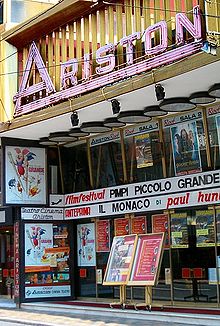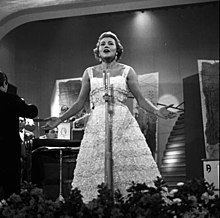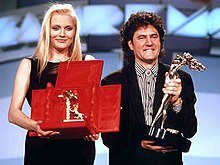
A | B | C | D | E | F | G | H | CH | I | J | K | L | M | N | O | P | Q | R | S | T | U | V | W | X | Y | Z | 0 | 1 | 2 | 3 | 4 | 5 | 6 | 7 | 8 | 9
| Italian Song Festival Festival della canzone italiana | |
|---|---|
 Teatro Ariston in Sanremo during the final night of the festival in 2013 | |
| Genre |
|
| Dates | February |
| Location(s) | Sanremo, Liguria, Italy |
| Years active | 1951–present |
| Website | sanremo |
| Music of Italy | ||||||||
| General topics | ||||||||
|---|---|---|---|---|---|---|---|---|
| Genres | ||||||||
| Specific forms | ||||||||
| Gregorian chant | ||||||||
| Media and performance | ||||||||
|
||||||||
| Nationalistic and patriotic songs | ||||||||
|
||||||||
| Regional music | ||||||||
|
||||||||
The Sanremo Music Festival (Italian: Festival di Sanremo [ˈfɛstival di sanˈrɛːmo, festiˈval -]), officially the Italian Song Festival (Italian: Festival della canzone italiana) is the most popular Italian song contest and awards ceremony, held annually in the city of Sanremo, Liguria.[1][2][3][4] It is the longest-running annual TV music competition in the world on a national level (making it one of the world's longest-running television programmes)[5] and it is also the basis and inspiration for the annual Eurovision Song Contest.[6][7]
Unlike other awards in Italy, the Sanremo Music Festival is a competition for new songs, not an award to previous successes (like the Premio regia televisiva for television, the Premio Ubu for stage performances, and the Premio David di Donatello for motion pictures).
The first edition of the Sanremo Music Festival, held between 29 and 31 January 1951, was broadcast by RAI's radio station Rete Rossa, and its only three participants were Nilla Pizzi, Achille Togliani, and Duo Fasano.[8] Starting from 1955, all editions of the festival have been broadcast live by the Italian TV station Rai 1.[9][10]
From 1951 to 1976, the festival took place in the Sanremo Casino, but starting from 1977, all the following editions were held in the Teatro Ariston,[11] except in 1990, which was held at the Nuovo Mercato dei Fiori.[12]
The songs selected in the competition are in Italian or in any regional language, and the three most voted songs are awarded. Other special awards are also given, including the Critics' Award, created ad hoc by the press in 1982 to reward the quality of Mia Martini's song, and named after the singer in 1996, after her death.
The Sanremo Music Festival has often been used as a method for choosing the Italian entry for the Eurovision Song Contest.[13][14] It has launched the careers of some of Italy's most successful musical acts, including Gigliola Cinquetti,[15] Laura Pausini,[16] Eros Ramazzotti,[17] Andrea Bocelli,[18] Giorgia,[19] and Måneskin.[20]
Between 1953 and 1971 (except in 1956), in 1990,[21][22] and 1991,[23] each song was sung twice by two different artists, each one using an individual orchestral arrangement, to illustrate the meaning of the festival as a composers' competition, not a singers' competition. During this era of the festival, it was custom that one version of the song was performed by a native Italian artist while the other version was performed by an international guest artist.[24] This became a way for many international artists to debut their songs on the Italian market, including Louis Armstrong, Ray Charles, Stevie Wonder, Cher, Gloria Gaynor, Dionne Warwick, Jose Feliciano, Roberto Carlos, Paul Anka, Miriam Makeba, Bonnie Tyler, Shirley Bassey, Mungo Jerry, Kiss, Laura Branigan, and many others.
History
Origin and development

In the aftermath of World War II, one of the proposals to revitalize the economy and the reputation of Sanremo was to create an annual music festival to be held in the city.[25]
In 1948 and 1949, the first two editions of the Italian Song Festival (Festival della Canzone Italiana) were held in Viareggio, from an idea developed in 1947 by Aldo Valleroni. The competition was discontinued in 1950 due to financial problems, but it became the basis for the future Sanremo Music Festival.[26][27]
During the summer of 1950, the administrator of the Sanremo Casino, Piero Bussetti, and the conductor of the RAI orchestra, Giulio Razzi, rediscussed the idea, deciding to launch a competition among previously unreleased songs.[28] Officially titled Festival della Canzone Italiana (literally "Festival of the Italian song"), the first edition of the show was held at the Sanremo Casino on 29, 30, and 31 January 1951.[25] The final round of the competition was broadcast by Rete Rossa, the second most important RAI radio station.[29] Twenty songs took part in the competition, performed by three artists only–Nilla Pizzi, Duo Fasano, and Achille Togliani.[24]
Starting from the third edition of the festival, held in 1953, each song was performed by two different artists with different orchestras and arrangements.[30] Two years later, in 1955, the festival made its first appearance on television, since part of the final night was also broadcast by RAI's channel Programma Nazionale.[31] The last night of the show was also broadcast in Belgium, France, Germany, the Netherlands, and Switzerland.[29]
In 1964, Gianni Ravera, who organized the 14th Sanremo Music Festival, slightly changed the rules of the contest, requiring each song to be performed once by an Italian artist and once by an international singer,[32] who was allowed to perform the song in any language.[24] The same rule was applied in the following year's contest.[33] Between 1967 and 1971, entries were not forced to be interpreted by foreign artists, but double performances were kept. Starting from 1972, each entry was sung by one artist only.[34]

The competing artists were split for the first time into "Big artists" and "Young artists" during the Sanremo Music Festival 1974. The competition had one winner only, but the entries in the "Young artists" category had to go through an elimination round, while "Big artists" were directly admitted to the final round.[24]
In 1977, the Sanremo Casino, which hosted all the previous editions of the contest, was closed for renovations, therefore the show moved to the Teatro Ariston.[35] The theater later became the usual location for the annual contest,[36] hosting it every year except in 1990, when the show was held at the Nuovo Mercato dei Fiori, also known as Palafiori.[37]
In 1980, pre-recorded backing tracks replaced the orchestra, while playback performances were allowed in 1983 during the final round.[38] In 1984 and 1985, all the artists were forced to perform in playback, while live performances with the orchestra were reintroduced in 1990.[38] During the same years, several other changes were introduced in the contest. In 1982, accredited music journalists decided to create an award to recognise the best song competing in the festival. Starting from 1983, the prize was officially awarded during the event. The critics' prize was later named after Mia Martini, who was the first artist receiving it in 1982 for her entry "E non finisce mica il cielo".[39]
Moreover, starting from 1984, the separation between newcomers and established artists was marked, introducing two different competitions with separate winners.[24] In 1989, a third category, the Upcoming Artists Section, was introduced, but it was removed the following year.[40] Only in 1998 were the top three artists in the newcomer section allowed to compete in the main competition. This led to the victory of the debuting Annalisa Minetti, which generated some controversy and led to the reintroduction of completely separate competitions starting from 1999.[41]
The distinction among different categories was abolished again in 2004.[42] The following year, the contest included five different categories—Newcomers, Men, Women, Groups, and Classics. The winner of each category competed for the final victory of the contest.[43] The category Classic was abolished in 2006,[44] while starting from 2007, the festival came back to the rules used in the 1990s, with two completely separate competitions for established artists and newcomers.[45]
In 2009, a new competition, held entirely online, was introduced by the artistic director of the 59th edition of the contest, Paolo Bonolis. Titled Sanremofestival.59,[46] the contest was not held in the following years.
Winners
Big Artists section
1950s


| Year | Song | Artist(s) |
|---|---|---|
| 1951 | "Grazie dei fiori"[47] (Saverio Seracini, Gian Carlo Testoni, Mario Panzeri) |
Nilla Pizzi |
| 1952 | "Vola colomba"[47] (Carlo Concina, Bixio Cherubini) |
Nilla Pizzi |
| 1953 | "Viale d'autunno"[48] (Giovanni D'Anzi) |
Carla Boni & Flo Sandon's |
| 1954 | "Tutte le mamme"[49][50] (Eduardo Falcocchio, Umberto Bertini) |
Giorgio Consolini & Gino Latilla |
| 1955 | "Buongiorno tristezza"[51] (Mario Ruccione, Giuseppe Fiorelli) |
Claudio Villa & Tullio Pane |
| 1956 | "Aprite le finestre"[49] (Virgilio Panzuti, Giuseppe Perotti) |
Franca Raimondi |
| 1957 | "Corde della mia chitarra"[48] (Mario Ruccione, Giuseppe Fiorelli) |
Claudio Villa & Nunzio Gallo |
| 1958 | "Nel blu, dipinto di blu"[52][53] (Domenico Modugno, Franco Migliacci) |
Domenico Modugno & Johnny Dorelli |
| 1959 | "Piove (Ciao, ciao bambina)"[49] (Domenico Modugno, Dino Verde) |
Domenico Modugno & Johnny Dorelli |
1960s


1970s



| Year | Song | Artist(s) |
|---|---|---|
| 1970 | "Chi non lavora non fa l'amore"[64] (Adriano Celentano, Ferdinando De Luca, Luciano Beretta, Miki Del Prete) |
Adriano Celentano & Claudia Mori |
| 1971 | "Il cuore è uno zingaro"[65] (Claudio Mattone, Franco Migliacci) |
Nada & Nicola Di Bari |
| 1972 | "I giorni dell'arcobaleno"[66] (Nicola Di Bari, Piero Pintucci, Dalmazio Masini) |
Nicola Di Bari |
| 1973 | "Un grande amore e niente più"[67] (Peppino Di Capri, Claudio Mattone, Gianni Wright, Giuseppe Faiella, Franco Califano) |
Peppino Di Capri |
| 1974 | "Ciao cara, come stai?"[68] (Cristiano Malgioglio, Italo Ianne, Claudio Fontana, Antonio Ansoldi) |
Iva Zanicchi |
| 1975 | "Ragazza del sud"[69] (Rosangela Scalabrino) |
Gilda |
| 1976 | "Non lo faccio più"[70] (Salvatore De Pasquale, Fabrizio Berlincioni, Salvatore De Pasquale, Sergio Iodice) |
Peppino Di Capri |
| 1977 | "Bella da morire"[71] (Renato Pareti, Alberto Salerno) |
Homo Sapiens |
| 1978 | "...e dirsi ciao"[72] (Piero Cassano, Carlo Marrale, Antonella Ruggiero, Salvatore Stellitta, Giancarlo Golzi) |
Matia Bazar |
| 1979 | "Amare"[73] (Sergio Ortone, Piero Soffici, Pietro Finà) |
Mino Vergnaghi |
1980s



| Year | Song | Artist(s) |
|---|---|---|
| 1980 | "Solo noi"[74] (Toto Cutugno) |
Toto Cutugno |
| 1981 | "Per Elisa"[75] (Franco Battiato, Giusto Pio, Alice Visconti) |
Alice |
| 1982 | "Storie di tutti i giorni"[76] (Riccardo Fogli, Maurizio Fabrizio, Guido Morra) |
Riccardo Fogli |
| 1983 | "Sarà quel che sarà"[77] (Maurizio Fabrizio, Roberto Ferri) |
Tiziana Rivale |
| 1984 | "Ci sarà"[78] (Dario Farina, Cristiano Minellono) |
Al Bano and Romina Power |
| 1985 | "Se m'innamoro"[79] (Dario Farina, Cristiano Minellono) |
Ricchi e Poveri |
| 1986 | "Adesso tu"[80] (Eros Ramazzotti, Piero Cassano, Adelio Cogliati) |
Eros Ramazzotti |
| 1987 | "Si può dare di più"[81] (Umberto Tozzi, Giancarlo Bigazzi, Raffaele Riefoli) |
Gianni Morandi, Enrico Ruggeri & Umberto Tozzi |
| 1988 | "Perdere l'amore"[82] (Marcello Marrocchi, Giampiero Artegiani) |
Massimo Ranieri |
| 1989 | "Ti lascerò"[83] (Franco Fasano, Fausto Leali, Franco Ciani, Fabrizio Berlincioni, Sergio Bardotti) |
Anna Oxa & Fausto Leali |
1990s


| Year | Song | Artist(s) |
|---|---|---|
| 1990 | "Uomini soli"[84] (Valerio Negrini, Roby Facchinetti) |
Pooh & Dee Dee Bridgewater |
| 1991 | "Se stiamo insieme"[85] (Riccardo Cocciante, Mogol) |
Riccardo Cocciante |
| 1992 | "Portami a ballare"[86] (Luca Barbarossa) |
Luca Barbarossa |
| 1993 | "Mistero"[87] (Enrico Ruggeri) |
Enrico Ruggeri |
| 1994 | "Passerà"[88] (Aleandro Baldi) |
Aleandro Baldi |
| 1995 | "Come saprei"[89] (Eros Ramazzotti, Vladimiro Tosetto, Adelio Cogliati, Giorgia Todrani) |
Giorgia |
| 1996 | "Vorrei incontrarti fra cent'anni"[90] (Rosalino Cellamare) |
Ron with Tosca |
| 1997 | "Fiumi di parole"[91] (Fabio Ricci, Alessandra Drusian, Carmela Di Domenico) |
Jalisse |
| 1998 | "Senza te o con te"[92] (Massimo Luca, Paola Palma) |
Annalisa Minetti |
| 1999 | "Senza pietà"[93] (Alberto Salerno, Claudio Guidetti) |
Anna Oxa |
2000s

